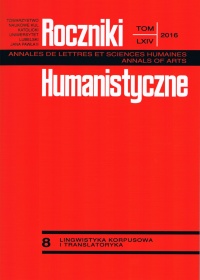Word-Formation Models of Nouns in the Struggle With Biology Taxonomies: Polish and French Examples
Abstract
The article contains reflection on the description methods of names in biology taxonomies and in terminology. Important for the description are the levels of taxonomies of organisms and conceptual hierarchies in terminology (hyperonymic-hyponymic relations). The terms of the basic level (level of species) are featured as those naming a single specimen and the basic terms (level of genus) as those forming a basis for creating new words. Two tendencies may be observed in the word-formation models of biological terminology: the derivative nouns name concepts from the superior level of family and order, and the endocentric compound nouns name concepts from the subordinate level of species. The juxtaposition of name formation by biologists with the methodology of linguistic description will allow specialists use language more consciously and linguists better recognize and understand the described elements of reality.
References
Bartmiński Jerzy, 1991, „Miejsce hiperonimu w definicji leksykograficznej”, [in :] Words are Physisians for an Ailing Mind. Księga ku czci prof. A. Bogusławskiego. (dir). Maciej Grochowski and Daniel Weiss, München, „Sangers Slavistische Sammlung” Bd 17, 45-50.
Depecker Loïc, 2003, Entre signe et concept : éléments de terminologie générale, Paris, Presses Sorbonne Nouvelle. (Réimpression 2009).
Jraissati Yasmine, 2009, Couleur, culture et cognition : examen epistémologique de la théorie des termes basiques, Thèse de doctorat, Institut Jean Nicot, École des Hautes Études en Sciences Sociales
Kleiber Georges, 1990, La sémantique du prototype, Paris, PUF.
Krąpiec Mieczysław, 1995, Język i świat realny, Lublin, wyd. II, 2015.
Lerat Pierre, 1995, Les langues spécialisées. Paris, PUF.
Lerat Pierre, 2010, “Variabilité et harmonisation terminologique”; Publifarum (www.publifarum. farum.it, n° 12, Atti Convegno Assiterm 2009).
Matile Loïc, Tassy Pascal, Goujet Daniel, 1987, Introduction à la systématique zoologique, Paris, Editions Météorologiques, traduit en polonais 1993, Wstęp do systematyki zoologicznej : koncepcje, zasady, metody, Warszawa: PWN.
Mayr Ernst, 1970, Populations, Species, and Evolution : An Abridgment of Animal Species and Evolution, Cambridge (Massachusetts), The Belknap Press of Harvard University Press
Moeschler Jacques et Anne Reboul, 1998, La pragmatique aujourd’hui, Paris, Seuil.
Otman Gabriel, 1996, Les représentation sémantiques en terminologie, Paris, Masson.
Rastier François, 2001, Sémantique et recherches cognitives, Paris, PUF, (2e éd.).
Sfar Inès, 2013, Les collocations dans le discours spécialisé : le cas de la terminologie ornithologique, Language Design, 14 : 19-38.
Śliwa Dorota, 2011 « Les inférences à fondement lexical – pour une dimension ontologique de la sémantique lexicale », Actes du Colloque « La ‘logique’ du sens : de la sémantique à la lexicographie : débat critique autour des propositions de Robert Martin », Metz 2011, Recherches Linguistiques, 32, 229-238.
Śliwa Dorota, 2013, Formation des noms et des termes composés français et polonais : de la cognition à la traduction, Lublin, TN KUL.
Śliwa Dorota (à paraître), „Greka i łacina w globalizacji terminów nauk przyrodniczych – polskie i francuskie nazwy ryb i dziesięcionogów w rozporządzeniach UE”, UAM, Poznań.
Tillier Simon, 2005 « Terminologie et nomenclatures scientifiques : l’exemple de la taxonomie zoologique », Langages, 157, 104-117, DOI : 10.3917/lang.157.0104.
Copyright (c) 2016 Roczniki Humanistyczne

This work is licensed under a Creative Commons Attribution-NonCommercial-NoDerivatives 4.0 International License.





